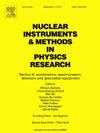5×5×12 mm3 虚拟弗里施栅 TlBr 探测器的性能鉴定
IF 1.5
3区 物理与天体物理
Q3 INSTRUMENTS & INSTRUMENTATION
Nuclear Instruments & Methods in Physics Research Section A-accelerators Spectrometers Detectors and Associated Equipment
Pub Date : 2025-04-11
DOI:10.1016/j.nima.2025.170528
引用次数: 0
摘要
溴化铊(TlBr)由于其高原子序数(Tl = 81, Br = 35),高密度(7.56 g/cm3)和相对较低的熔点(460°C),是一种很有前途的半导体伽马射线探测器材料。这些特性赋予了TlBr几个具有竞争力的特性,包括高探测效率、良好的能量分辨率和较低的制造成本,使其适合需要紧凑、高灵敏度伽马射线探测系统的应用。TlBr探测器的最新发展已经向更厚的晶体发展,可达10-20毫米,配置为像素化或虚拟Frisch-grid (VFG)设备,体积为1 cm3。尽管取得了这些进步,但在实际应用中仍然存在挑战,包括影响能量分辨率、器件稳定性、性能和寿命的材料和制造问题。这些挑战类似于HgI2和卤化铅钙钛矿探测器所面临的挑战。本研究介绍了由辐射监测设备公司制造的100多个位置敏感5×5×12 mm3虚拟飞盘网格探测器的特性。用于原型放射性同位素识别装置(RIID)。这项工作确定了限制TlBr探测器性能和寿命的因素,包括随机响应变化,将大多数设备的能量分辨率限制在2 - 3% (662 keV),与缺陷装饰相关的性能下降,以及接触分层。解决这些问题将推动TlBr和类似材料的可靠、高分辨率伽马射线光谱的使用。本文章由计算机程序翻译,如有差异,请以英文原文为准。
Performance characterization of 5×5×12 mm3 virtual Frisch-grid TlBr detectors
Thallium bromide (TlBr) is a promising material for semiconductor gamma-ray detectors due to its high atomic number (Tl = 81, Br = 35), high density (7.56 g/cm3), and relatively low melting point (460 °C). These properties give TlBr several competitive features, including high detection efficiency, good energy resolution, and lower fabrication costs, making it suitable for applications requiring compact, highly sensitive gamma-ray detection systems.
Recent developments of TlBr detectors have progressed toward thicker crystals, up to 10–20 mm, configured as pixelated or virtual Frisch-grid (VFG) devices with volumes >1 cm3. Despite these advances, challenges remain in practical implementation, including material and fabrication issues that affect energy resolution, device stability, performance, and longevity. These challenges are similar to those faced by HgI2 and lead-halide perovskite detectors.
This study presents results from characterizing over 100 position-sensitive 5×5×12 mm3 virtual Frisch-grid detectors fabricated by Radiation Monitoring Devices Inc. For a prototype Radioisotope Identification Device (RIID). The work identified factors limiting the performance and longevity of TlBr detectors, including stochastic response variations that limit the energy resolution to 2–3 % (at 662 keV) for most devices, performance degradation associated with defect decoration, and contact delamination. Addressing these issues advances the use of TlBr and similar materials for reliable, high-resolution gamma-ray spectroscopy.
求助全文
通过发布文献求助,成功后即可免费获取论文全文。
去求助
来源期刊
CiteScore
3.20
自引率
21.40%
发文量
787
审稿时长
1 months
期刊介绍:
Section A of Nuclear Instruments and Methods in Physics Research publishes papers on design, manufacturing and performance of scientific instruments with an emphasis on large scale facilities. This includes the development of particle accelerators, ion sources, beam transport systems and target arrangements as well as the use of secondary phenomena such as synchrotron radiation and free electron lasers. It also includes all types of instrumentation for the detection and spectrometry of radiations from high energy processes and nuclear decays, as well as instrumentation for experiments at nuclear reactors. Specialized electronics for nuclear and other types of spectrometry as well as computerization of measurements and control systems in this area also find their place in the A section.
Theoretical as well as experimental papers are accepted.

 求助内容:
求助内容: 应助结果提醒方式:
应助结果提醒方式:


